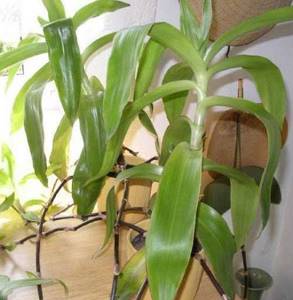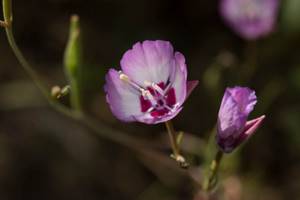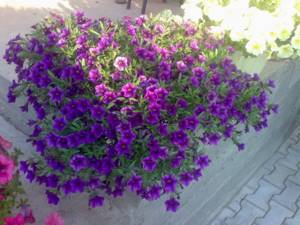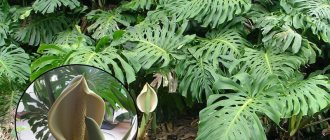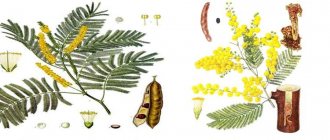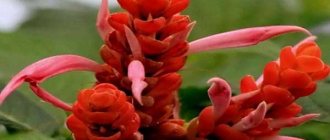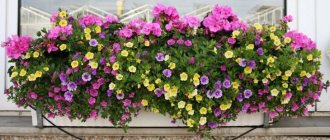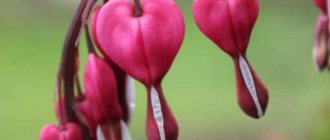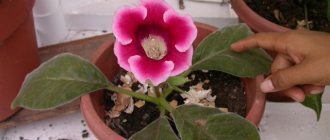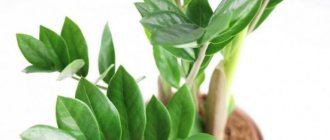Callisia at home, care and photos
Author: Natalya March 01, 2021 Category: Houseplants
Callisia (lat. Callisia) is a genus of evergreen herbaceous perennials of the Commelinaceae family, growing in the humid penumbra of the tropics and subtropics of the Antilles, as well as the countries of Central and South America.
There are 12 species in the genus, and some of them are grown indoors. The name of the plant comes from two Greek words that translate as “beautiful” and “lily,” although the closest relative of callisia is not the lily, but Tradescantia.
Planting and caring for callisia
- Flowering: In indoor culture it blooms infrequently, usually in late summer or early autumn.
- Lighting: bright diffused light or partial shade.
- Temperature: during the period of active growth – 20-24 ºC, in autumn and winter – 16-18 ºC. The lower temperature limit is 14 ºC.
- Watering: during the growing season - as the top layer of the substrate dries. In winter, between waterings, the substrate should dry to a third of its depth.
- Humidity: high. In hot weather, it is recommended to regularly spray the leaves with a fine spray.
- Feeding: from April to October - 2 times a month with a solution of complex mineral fertilizer. During the rest of the year, you don’t need to apply fertilizer.
- Dormant period: from November to March.
- Replanting: young plants - annually, adults - once every 2-3 years.
- Reproduction: apical cuttings, layering, rhizome division.
- Diseases: loss of decorativeness as a result of poor care or violation of maintenance conditions.
- Pests: thrips and spider mites.
- Properties: the plant does not tolerate tobacco smoke.
Brief description of cultivation
- Bloom . At home, callisia flowering is a rather rare occurrence. As a rule, this happens in the last summer or first autumn weeks.
- Illumination . Grows well in light shade or in diffused bright light.
- Temperature regime . In the spring-summer period - from 20 to 24 degrees, and in the cold season - from 16 to 18 degrees. Make sure that the room is not colder than 14 degrees.
- Watering . During the growing season, the bush is watered immediately after the top layer of the substrate has dried. In winter, the soil mixture is moistened only after it has dried to a depth of 1/3.
- Humidity . Requires high air humidity. On hot days, you need to systematically moisten the foliage with a spray bottle.
- Fertilizer . The flower is fed in April–October once every 15 days, using a solution of a mineral complex. In other months, the plant is not fed.
- Rest period . November–March.
- Transplant . While the bush is young, it is replanted regularly once a year, and older specimens are subjected to this procedure less often (once every 2 or 3 years).
- Reproduction . Layering, apical cuttings and dividing the rhizome.
- Diseases . The decorative quality of the plant may suffer due to improper care or unsuitable growing conditions.
- Pests . Spider mites and thrips.
- Properties . The flower reacts extremely negatively to tobacco smoke.
Creeping callisia - Callisia repens. Propagation by cuttings // Indoor flowers
Caring for callisia at home
How to care for callisia at home
The callisia flower requires maintenance under bright diffused light, but with shading from direct sunlight. In a well-lit room, callisia can be placed even away from the window. The indoor callisia plant is not a flower for the kitchen: it does not tolerate tobacco smoke, fumes, impurities and needs a constant supply of fresh air, so indoor callisia likes to spend the summer on the balcony or in the garden. This plant can be grown not only in residential premises, but also in offices, providing ventilation without drafts, which harm the flower even more than stale air.
Callisia is quite suitable at ordinary room temperature: 20-24 ˚C in summer, 16-20 ˚C in winter. However, callisia should be protected from sudden changes and low temperatures: the lower limit for the plant in winter is +14 ˚C.
Watering and feeding callisia
During the period of active growth, that is, from spring to autumn, callisia is watered with soft water at room temperature as soon as the top layer of soil in the pot dries. In winter, watering is reduced, especially if the callisia's dormant period is cool.
However, the substrate in the pot should not be allowed to dry out completely: the plant may die. When watering, water should not get into the center of the rosette: this can cause rot.
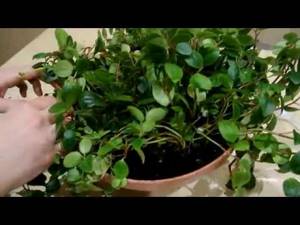
The tropical callisia flower requires high air humidity, especially in the summer heat and winter, when the heating devices in the apartment are operating at full capacity. To prevent the plant from suffering from dry air, it will have to be frequently sprayed with a fine spray or a household humidifier.
From April to October, callisia is fed with a solution of complex mineral fertilizer 2 times a month; the rest of the time the plant does not need feeding.
Callisia transplant
Young callisia is replanted annually, adult - once every 2-3 years. The plant is transferred into a pot filled one quarter of the volume with expanded clay or pebbles, which should be 2 cm larger in diameter than the old pot, and the remaining space is filled with a mixture of equal parts of turf soil, humus, sand and leaf soil. After transplantation, callisia is watered.
Related article: Ruellia flower: home care, photo, growing from seeds
Some gardeners believe that replanting callisia is pointless; it is better to grow a new plant from cuttings. If your callisia in the lower part of the stems is very bare, then it is probably better to actually carry out cuttings instead of replanting. However, with good care, the plant ages and does not grow so quickly.
Reproduction of callisia
Callisia is propagated throughout the year in the same ways as tradescantia, ivy or hoya. For example, cut off the apical cutting with 3-4 internodes, lower the cut into water and wait for the roots to grow. Rooted cuttings are planted several at a time in a pot with substrate. It is also easy to propagate callisia by layering: the shoot is buried at the level of the second or third node, right in the pot with the plant, if space allows, or another pot with a substrate is placed next to it and the layering is buried in it. As soon as the shoot takes root, it is separated from the mother plant.
When transplanting, you can divide the callisia into parts and plant them in different pots.
Rules for caring for escallonia
Considering the origin of the plant, it is easy to assume that escallonia has no special care requirements. In its natural habitat, the shrub grows on mountain slopes, which makes it resistant to unfavorable conditions. But modern cultivated varieties can die if not properly cared for. What do you need to know about the features of keeping such a plant in your garden?
Planting escallonia
In the southern regions, planting is carried out before winter. In colder areas, it is recommended to postpone the procedure to the beginning of spring. Otherwise, the plant may not have time to take root before the onset of frost.
To grow escallonia, it is advisable to choose places that are well lit by sunlight. In the shade, the plant will lose its decorative effect and may not bloom. The presence of strong drafts also has a negative effect on it. It is recommended to choose places protected from gusts of wind.
Escallonia has no special soil requirements. It should be loose and fertile. Loam or sandy loam soil is suitable. For planting, it is necessary to prepare a hole 0.6x0.6 m. A drainage layer must be laid on the bottom. After this, the seedling is installed and covered with soil.
It is important not to damage the earthen ball when carrying out manipulations.
When the transplanting process is completed, a hole is formed around the trunk and filled with plenty of water.
Escallonia pruning
After planting, it is necessary to perform formative pruning of the plant. To do this, all new shoots are shortened by half. This will allow the plant to grow not in height, but in width, acquiring a beautiful shape.
In the future, formative pruning will not be necessary. A sanitary procedure will suffice, in which all old and dried out shoots and inflorescences are removed. This allows you to relieve the load on the plant and stimulate the growth of new branches.
Watering escallonia
The shrub does not like excessive watering. This reduces access to oxygen to the roots, causing them to rot. It is recommended to water no more than 2-3 times every 2 weeks. In conditions of abnormally hot weather, the amount of irrigation is adjusted as the top layer of soil dries out. With a lack of moisture, the plant begins to shed its leaves and dry out.
Escallonia placement
Escallonia is considered one of the most beautiful ornamental shrubs. Therefore, it is not worth placing it in the backyard of the garden. It looks great against the background of flower arrangements, in borders and single plantings.
If there is good lighting, the shrub will delight its owners with bright, abundant flowering and beautiful luster of foliage.

Pests and diseases of callisia
Callisia diseases and their treatment
Callisia is almost not affected by infections, but if the plant suddenly starts to get sick, then this is entirely your fault: apparently, you did not create the necessary conditions for it or did not care for it well.
- For example, if the tips of callisia leaves begin to dry, this means that the plant is experiencing a chronic lack of moisture and is suffering from dry air.
- Poor lighting leads to stretching of shoots and loss of callisia leaves.
- Stagnation of water in the roots due to poor drainage or too frequent watering can result in leaf drop and root rot.
Read again the chapter on the conditions for keeping callisia and recommendations for caring for the plant, and then correct any errors found.
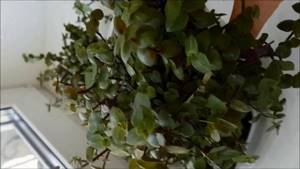
Callisia pests and their control
Among the pests, callisia can be attacked by thrips and spider mites. Both of these pests feed on the sap of the plant through bites in the leaves, causing them to turn yellow and fall off, and the plant gradually withers. Thrips can be destroyed with insecticidal preparations, and ticks with acaricidal preparations. It is advisable to carry out treatments outdoors, since these drugs are toxic to people and pets.
Subtleties of plant care
In order for the golden mustache to grow into a strong, healthy and beautifully flowering plant, it is necessary to follow certain measures to care for it. First of all, you should make sure that the collision grows in suitable soil: it should be light, well-drained (it is advisable to use loam).
The room in which the plant will be located must be warm enough, because golden mustache is by nature a tropical flower. The air temperature should never be below zero.
In order for the plant to feel comfortable and grow strong and healthy, fertilizers should be periodically added to the soil. You can use organic matter, you can choose a ready-made mineral complex (it is better to give preference to fertilizers with a predominance of nitrogen, phosphorus and potassium in their composition).
Watering should be regular, but not too abundant: it is better if the soil in the pot with the plant is constantly moist, but the golden mustache should not actually float in the water. The optimal time to water the plant is in the morning. During the cold period of the year (starting from the first cool days of September), it is advisable to minimize watering to 1-2 times a week: this amount of moisture will be quite enough for the plant.
Pay special attention to the location of the plant in the room: it is advisable to leave it in partial shade or even shade. Advice
Collision is very fond of acidic water, so it is advisable to slightly acidify it immediately before adding it to the soil. This can be achieved using regular citric acid: just 1 teaspoon of powdered citric acid or freshly squeezed lemon juice per 1 liter of water is enough. Maintain constant soil moisture
Advice. Collision is very fond of acidic water, so it is advisable to slightly acidify it immediately before adding it to the soil. This can be achieved using regular citric acid: just 1 teaspoon of powdered citric acid or freshly squeezed lemon juice per 1 liter of water is enough.
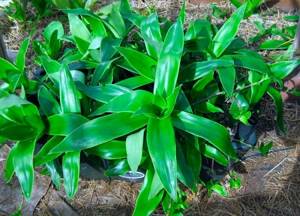
Maintain constant soil moisture
The plant rarely gets sick. Most often it is affected by various insect pests. This could be spider mites, aphids, etc. You can effectively fight them with the help of insecticides. But it is also possible to prevent the appearance of a pest on a plant: to do this, it is enough just to maintain the optimal temperature regime and watering schedule. By the way, maintaining an optimal watering regime will also help prevent changes in the appearance of the plant: in the absence of a sufficient amount of moisture, the leaves of the conflict will begin to turn yellow.
That's all the subtleties you should know when growing golden mustache at home. As you can see, this plant is highly decorative and does not require special care. The main thing is to remember the basic rules. Good luck!
Types and varieties of callisia
Elegant callisia (Callisia elegans)
Or graceful callisia - a miniature plant with articulated creeping stems more than half a meter long, which first grow straight and then droop. This plant is very similar to Tradescantia. It reaches a height of 30-40 cm. Both the leaves and stems of callisia graceata are covered with velvety pubescence. The oval, pointed at the ends, petiolate, up to 6 cm long leaf plates of the plant are painted violet-green on the underside, and dark green with silver stripes on the top. This species blooms with white flowers formed at the ends of the shoots. The plant does not live very long: after two years, the leaves, which lose their bright colors, no longer cover the shoot so tightly, so flower growers restore the vine by cuttings or layering.
Callisia navicularis
A changeable plant, the decorativeness of which depends on the variety and conditions of maintenance. This is a succulent with creeping stems that quickly take root at the nodes and succulent, lanceolate, strongly concave double-row leaves with a longitudinal hollow, painted on the upper side in a bronze-green color that shimmers red in the sun, and on the lower side - brownish-violet. The leaves are bare, but along a line ascending from the axil, covered with a fringe of small hairs, reaching a length of 2 and a width of 1.5 cm.
Creeping callisia (Callisia repens)
A plant up to 20 cm high and up to 30 cm wide with thin reddish or purple stems and small heart-shaped bright green leaves with purple specks located on them in two rows. The flowers of this species are white and inconspicuous. At home, callisia repens is grown in hanging structures, and in the garden it is used as a ground cover plant. The following garden forms are known:
- Bianca is a callisia with red-violet tender stems and small bright green leaves;
- Pink Panther is a variety with striped pink-green leaves.
Also popular are varieties of creeping callisia Pink Lady, Noum Popula and Tortle.
Fragrant callisia (Callisia fragrans)
Or Thai callisia, or golden mustache can also be found under the names “Far Eastern mustache”, “living hair”, “domestic ginseng” and “corn”. This is a larger plant than, for example, small-leaved creeping callisia grown at home. The height of fragrant callisia can reach one and a half meters, but it definitely needs support, otherwise the vine may break under its own weight. Callisia fragrans has two types of stems: short, fleshy and vertical, ending in a large rosette of leaves, and long, tubular horizontal shoots, jointed tendrils, which serve the plant to capture new area. The leaves of this species are fragrant, large, leathery, dark green, up to 30 cm long and up to 6 cm wide. They are glossy on the upper side, matte below, and when grown in bright light the leaves turn pink.
Transplantation and propagation
Golden mustache is replanted annually at a young age. Adult specimens are moved to a new container less frequently. For them, the procedure is carried out every 2-3 years. In the absence of transplants, the flower grows worse, its foliage becomes small, and the internodes become elongated. The soil for replanting is prepared independently from the following components:
- 1 part leaf soil;
- 1 part of turf land;
- 1 part peat;
- 1 part coarse river sand.
The pot is used 2-3 cm wider than the previous container. A drainage layer 4 cm thick is placed on the bottom. It is necessary to prevent moisture from stagnating at the roots. A small layer of fresh soil substrate is poured onto it. The bush is removed from the old container and placed into a new pot using the transfer method. All free space is filled with fresh soil. After transplantation, the golden mustache is watered with a moderate amount of water.
Propagation by cuttings

Stems with at least 10 internodes are suitable for cuttings. The stalk is cut at the level of the middle of the second joint. The stems are placed in a jar of water. Within 15 days, new roots appear. When they grow to a length of 2-3 cm, the cuttings are transplanted into a small container in soil intended for adult specimens.
Reproduction by layering
Rooting of cuttings using this method is carried out in the same pot with the mother bush or in an adjacent one. The selected stem is bent to the ground and pinned at the level of the third internode. When the roots are formed and the cuttings are firmly established in the soil, they are cut off from the mother bush. The young plant is transplanted into a new pot.
Reproduction by mustache
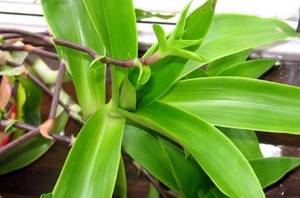
Whiskers are formed on the scented variety. Therefore, this method is used specifically for her. The mustache is a small process equipped with its own root system. It is separated from the mother bush and transplanted into a separate pot. Sometimes the mustache is not cut off immediately, but is allowed to take root like layering. Only after the young plant is fixed in the soil is pruning carried out.
Callisia
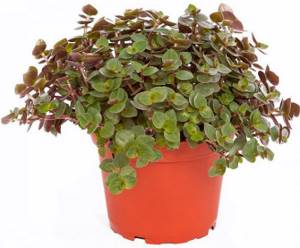
Callisia is an ampelous plant from the Commelinaceae family. It has external similarities with tradescantia and netcreasia. The plant is native to Central and South America. It grows in the tropics and subtropics, choosing moist places in partial shade. There is nothing complicated in caring for callisia. This compact plant with decorative green foliage fits perfectly into the interior of the room.
Related article: Whey fertilizer: how to use for root feeding
Several types of callisia are grown at home. The most popular is Callisia graceica. It was the first to be grown in homes. It has a juicy, strong stem and beautiful velvety dark green leaves with silver stripes. The inside of the leaves is purple in color. The leaves of Callisia navicularis, which tend to acquire a reddish tint in sunny weather, resemble a boat. Creeping callisia is a miniature specimen. A characteristic feature of this species are small leaves with purple specks.
Callisia fragrant is grown as a medicinal plant. People call it the “golden mustache”. It is especially popular in nursing homes. They believe that it cures all diseases. Its leaves may turn pink and emit a strong odor. This plant enriches the air with phytoncides. At night it is placed at the head of the bed to get rid of nightmares. With the help of a golden mustache they strengthen the immune system. It is effective for ulcers and intestinal diseases. The juice of the plant is used to heal wounds and ulcers.
In indoor conditions, the exotic beauty blooms extremely rarely. Externally, callisia flowers do not look very attractive, but they emit a subtle, pleasant aroma, very similar to the smell of lily of the valley or hyacinth. As a rule, the plant begins to bloom in early summer.
Varieties
Callisia fragrant, otherwise “golden mustache”
The shoots of this species are erect or horizontal, creeping, the plant is up to one and a half meters long. Callisia golden mustache rarely blooms, the callisia flower is inconspicuous, small, white, but fragrant, most often appears in May. The leaves are glossy, green to purple. Callisia “fragrant” is not confined to an ornamental variety; it is more valued as a medicinal plant, as well as for its ability to purify the air.
Callisia creeping
It grows quickly, the plant is small-leaved, the leaves are heart-shaped, purple with specks, and grows in “creeping” hanging pots or in large flowerpots. Not tall in size, from the category of miniature decorative flowers.
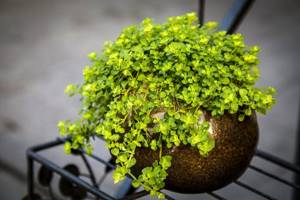
Callisia “graceful”, Callisia “elegant”
A medium-sized ornamental plant called callisia “elegant”, the second name is callisia “graceful”. The shoots creep. Oval-shaped, velvety leaves of green or dark green color. There are white stripes on the leaves. The reverse side of the leaf is purple. The stems are fleecy. White callisia flowers of this variety grow at the ends of the shoots in late summer.
Callisia “scaphoid” or Tradescantia callisia
Perennial evergreen herbaceous miniature Callisia navicularis, otherwise called Tradescantia navicularis. A bright, conspicuous creeping plant. The stems of the scaphoid callisia are short, the flowers are small pink or lilac, the bud has 3 petals.
Caring for callisia at home
Choosing a location, lighting
Plants with variegated leaves prefer bright but diffused light. They should be protected from direct rays of the sun, shading them with a light cloth. Callisia will be most comfortable on a western or eastern window in the warm season and on a southern window in winter. The beauty tolerates light shadow perfectly. It can be grown in the back of a bright room. The plant is ideal for offices. When grown in full shade, callisia grows and the distance between the leaves increases. It grows well in regularly ventilated spacious rooms. You shouldn’t keep it in the kitchen, or in a room where people smoke often. With the onset of summer, it is taken out onto the balcony.
Temperature
Callisia is an unpretentious indoor flower. It is thermophilic, so it can be kept at normal room temperature. The optimal temperature for summer is 20-25 degrees. In winter it can be reduced to 16 degrees. During the cold season, the room temperature should not fall below 14 degrees. If you keep an exotic beauty at high temperatures in winter, it will stretch out greatly. Low temperatures promote soft leaves. It should be remembered that the plant does not tolerate sudden changes in temperature and drafts.
Watering
In spring and summer, the plant needs regular watering. Water it as the soil dries. Water for irrigation should be soft (settled or rain). In winter, watering is reduced, paying attention to the room temperature. Overdrying of the earthen substrate can lead to the death of callisia. It is very important that when watering, liquid does not fall into the center of the outlet. Otherwise, the leaves will rot.
Humidity
Since the natural habitat of callisia is the tropics, it must be kept in conditions of high humidity. It needs regular spraying. But you need to spray the plant very carefully, with small droplets, so that the leaves do not lose their decorative effect. During the heating season, it is protected from the hot air of the radiators so that dry tips do not appear on the leaves.
Feeding
The tropical beauty needs regular feeding from May to September. Mineral fertilizers are applied every week.
Transfer
Many gardeners do not recommend replanting the plant when growing young specimens. Over time, the adult conflict loses its attractiveness, becoming naked. If you do not update it, young plants are replanted every year, and adults every two to three years. The indoor flower prefers slightly acidic soil. The soil substrate for planting should be prepared independently. The ideal composition of the soil mixture for callisia is turf, leaf soil, sand, peat and humus (one part of each ingredient). To avoid stagnation of water, ensure good drainage.
Reproduction
Callisia reproduces very easily. To get a new plant, you need to cut off the apical stalk, which has 2-3 nodes, and place it in a glass of water. The roots on the cuttings will appear very quickly, in about 2-3 weeks. To make the plant look more decorative, several cuttings should be planted in one pot.
There is another method of reproduction - layering. If there is space in the container with callisia, a shoot is dropped there at the level of the second or third node. If there is no space in the “parent pot,” a new container with soil is placed nearby. After rooting, the shoot is cut off.
Callisia can be propagated at any time of the year. But best results can be achieved in spring and summer.
Features of transplantation
Young plants are replanted every year in April-May. It is recommended to replant adult plants every few years. The soil for replanting consists of the following components:
- compost soil;
- leaf soil;
- sand.

All components are taken in equal proportions. A dense layer of drainage is placed at the bottom of the container to ensure the drainage of excess moisture.
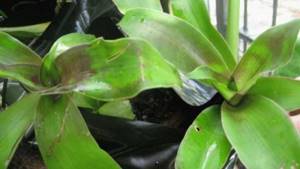
Fragrant callisia - description, types, features, care, transplantation + photo
In many apartments and houses you can find perennial evergreen callisia. This is not only a rather attractive herbaceous plant.

Callisia has many medicinal properties that allow it to be used in the manufacture of traditional medicine.
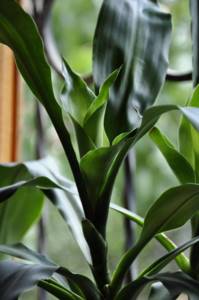
Healing substances of callisia fragrant

The mustache also contains the highly active substance beta-sitosterol. Autumn is the best time to prepare alcohol and oil tinctures.
Quercetin is a substance that slows down oxidative processes in the body, therefore, with the help of this substance, the aging process is slowed down. It also has anti-inflammatory, antiallergic, anti-edema, and antioxidant properties.
Kaemferol has a tonic property, strengthens capillaries, and can remove salts. This substance also has diuretic properties.
Another highly active substance contained in golden mustache is beta-sitosterol. It helps fight metabolic disorders, endocrine system diseases, atherosclerosis, inflammation of the prostate gland, as well as other inflammations and disorders of the body.
Description and characteristics of the plant
Callisia is distinguished by creeping stems. Sometimes you can find plants with erect stems. Their homeland is the subtropical and tropical part of America. Here they grow in damp areas.
Gardeners for home use recommend two types of this plant – elegant callisia or creeping callisia. But many people prefer to grow a medicinal variety - golden mustache.

The most suitable place for growth is a warm, fairly bright room with a constant flow of fresh air.
Related article: Tamarix shrub: planting and care in open ground, photo, propagation in the garden

It is not recommended to leave the collision in rooms saturated with various odors. In spring and autumn, pots can be taken out onto the veranda or balcony. It is better to plant it in wide vases; it is permissible to create compositions with other plants.
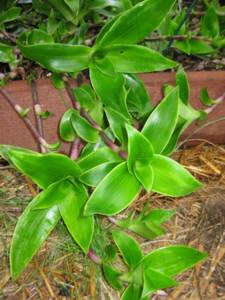
If you have animals in the house, then you need to purchase this plant with caution. After all, many species, for example, fragrant callisia, as well as creeping callisia, can cause allergies in them, manifested in discoloration of the skin and itching.
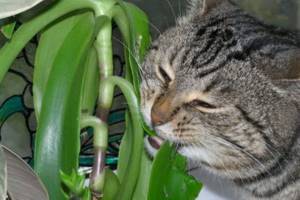
Proper care
By following simple rules of care, you can forget for a long time about the hassle associated with growing a plant, and also enjoy its flowering, which does not happen very often. Small white flowers (less than 1 centimeter in diameter) are formed at the tips of the shoots. They have a pleasant aroma that can be compared to lily of the valley or hyacinth.
Watering and spraying
In spring and summer, the golden mustache needs daily watering, but it is important to prevent the soil from becoming waterlogged. In autumn and winter, watering is reduced to 2-3 times a week, but if the room is hot, then, on the contrary, it is increased
The soil should be moist, but not swampy. It is recommended to carry out the procedure in the morning.
The leaves need to be sprayed with warm, settled water once every 2-3 days to wash away dirt and refresh, and in hot climates the procedure should be done regularly so that they do not dry out.
Fertilizer
After developing a strong root system for rapid growth, plants can be fed with liquid fertilizers
When purchasing such fertilizers, you should pay attention to the fact that the composition includes nitrogen, phosphorus and potassium.
You can make this fertilizer yourself: dilute ammonium nitrate (2.5 tsp), potassium salt (1 tsp), superphosphate (2 tsp) in 10 liters of water, adding a couple of drops of ferric chloride. This mixture should be used 2 times a month. Before starting fertilizing, it is recommended to water the soil well. When introducing fertilizer, you must ensure that the mixture does not get on the plant, which can cause burns.
Second preparation method: potassium salt (1.5 tsp), superphosphate (3 tsp), water (10 l). Also, watering is done first to protect against burns. This fertilizer can be applied every 2 weeks.
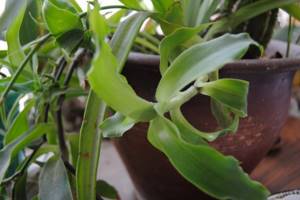
Important! Before applying fertilizer, abundant watering is necessary. Promotes the growth of callisia by watering with milk water (1/4 cup of milk per 1 liter of water)
You can wipe the leaves with cotton wool dipped in milk.
Watering with milk water (1/4 cup of milk per 1 liter of water) promotes the growth of callisia. You can wipe the leaves with cotton wool dipped in milk.
Species diversity
The callisia plant has many varieties that take root well in indoor conditions:
Elegant is a very small plant. It has strong and quite juicy creeping stems. A special feature is the beautiful velvety, egg-shaped leaves. Their color is dark green and purple underneath.

Silvery stripes are visible on the surface. The leaves are 3-6 cm long. They are arranged in 2 rows on each shoot.

Scaphoid callisia is a succulent. Its leaves are similar in appearance to a boat. Under bright sun they have a red tint.
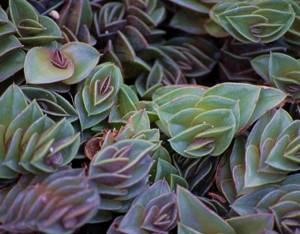
This is a fairly light-demanding species that needs to be watered infrequently. Shoots can be short or elongated.

Creeping is a small plant whose leaves do not exceed 2 cm in size. Purple dots are visible on their surface. The stem is thin, with leaves arranged in two rows. It is distinguished by its ability to grow quickly.
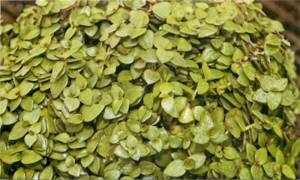
Fragrant, which is also called golden mustache. A plant with fairly large leaves 30 cm long has a height of up to 1.2 m. The leaves have a shine, and in bright light they acquire a pink tint.

Thick stems can be vertical with a large rosette or horizontal, on which leaves are placed in a spiral.
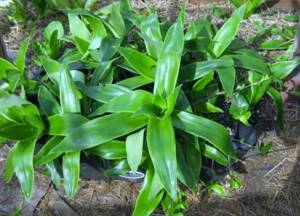
The photo of fragrant callisia shows that the plant can throw out horizontal shoots. This happens when the collision becomes mature. A rosette of leaves appears at the ends of the shoots.
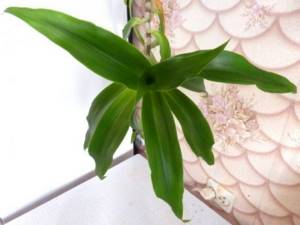
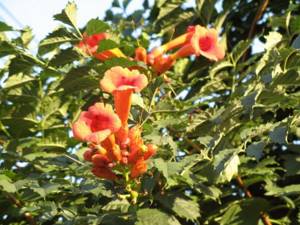
Description of fragrant callisia (golden mustache)
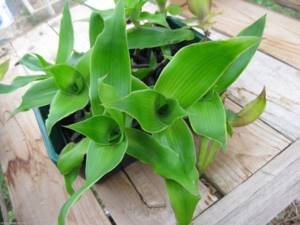
The plant has a long, erect stem, reaching a length of 1.5 meters in mature plants. In older plants, the lower leaves tend to dry out and then fall off, making the flower look like a palm tree.
Shoots, or as they are otherwise called, tendrils, originate from the stem and grow horizontally. At their ends, rosettes of young leaves are formed. The shoots consist of joints (knuckles), the number of which can be used to determine the age of the plant, and its healing properties depend on it.
The leaves of the golden mustache are fleshy with yellow veins, their color depends on the lighting and can be dark green or light green, or purple. Very small white or pale pink flowers with a delicate scent reminiscent of lily of the valley, hanging in small inflorescences. The plant blooms extremely rarely, and only if proper care is provided and favorable conditions are created for their growth. It is believed that the golden mustache blooms only in a house where the energy is positive, emitted by positive people.
How to care for callisia
The plant has some requirements for lighting - it should be bright, but diffused. To place the pot, you need to choose a bright or slightly shaded place in the house. The more intense the light, the brighter the leaves.

The plant prefers warm rooms with a temperature of 20-25 degrees during the spring-summer period, and in winter - not lower than 14 degrees. Sudden changes in temperature are harmful.
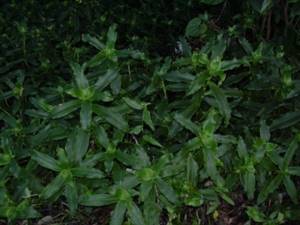
For the plant, you need to create conditions with high air humidity. To do this, it is necessary to regularly but carefully spray with water at room temperature.

Caring for callisia at home is not very difficult. For irrigation you need to use soft, settled water. If you need to water abundantly in summer, then reduce the frequency of watering in winter. Drying the soil should be avoided.
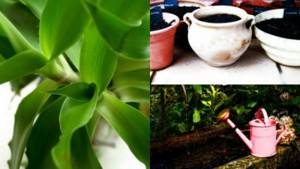
The boat-shaped plant requires even less watering in winter than other types. The plant needs regular feeding during the period April-September.
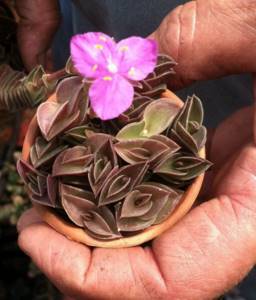
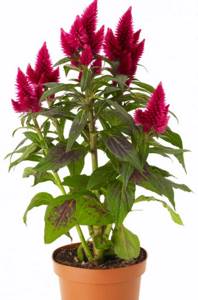
Nutrients are added every week. Complex mineral fertilizers are preferred.

Mistakes and care problems
Errors in caring for callisia are associated with violation of the rules for its maintenance. Knowing about the tropical origin of the flower, the owners place it on the window in the hottest place, in winter - closer to the radiator.
If there is a cat in the house, then you need to protect the flower from its teeth, since animals love to eat indoor flowers. If placed in a draft, it will die. If you allow a temperature drop in winter, the leaves will lose moisture and become flabby. The sprouts will die.
Callisia is a plant from the Tradescantia genus that grows naturally in tropical latitudes. About 12 types of flowers are grown as indoor plants. Callisia propagates by cuttings and layering. Requires frequent watering and irrigation in the summer.
Growing and transplanting
When growing callisia at home, it is difficult to get it to bloom. This happens in the first weeks of summer. The flowers are small and white. They are formed in the upper part of the shoots and have a fairly pleasant smell.
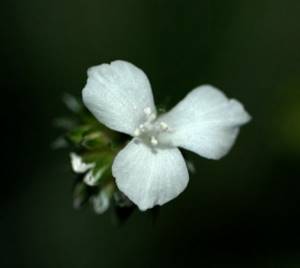
If you prefer hanging balls from hanging plants, then you need to choose shaded areas of the house to place them. It is necessary to make a wire frame with large cells and a hook for hanging it.
To prevent the soil from spilling out of the frame, moistened sphagnum is placed inside it. Additionally, you can strengthen the walls using nylon with holes for cuttings or a fabric-type mesh. Then the wet soil mixture is placed inside. Plant cuttings are planted on all sides of the sphagnum.
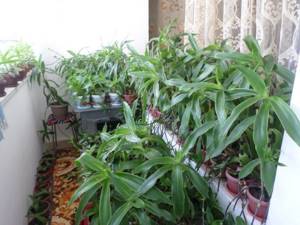
The resulting ball must be sprayed with water. For the first days, it should be kept wrapped in plastic in the light. Then the film should be removed and the plant should be left in low light for 1 day, not forgetting to spray it.
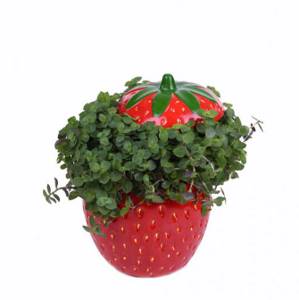
If rooting is weak, you can add more planting material. The substrate must be watered regularly, and the plant itself must be turned to the light in different directions.
The plant must be regularly rejuvenated using apical cuttings. They need to be planted in a pot with nutritious soil. The shoot will be ready if more than 12 “joints” appear on the shoot.

Diseases
The most common problem of Callisia is root and stem rot , which is facilitated by the constant moisture of the earthen clod and the lack of good drainage.
To eliminate the problem, all affected parts of the plant are removed, and the sections are treated with crushed charcoal. Completely replace the soil in the pot with new one.
For extensive lesions, treat with fungicides. You can use Acrobat, Bayleton, Profit, Oksikhom, Rovral.
Features of plant propagation
To obtain a cutting, the top of the callisia is cut off at a distance of 2 “joints” from the rosette of leaves. The cut is made in . The cuttings are rooted in plain water, and after 7-10 days, when the root has formed, it is transplanted into the ground. Complete rooting occurs in 2-3 weeks.

The procedure for planting fragrant callisia is not too complicated. This is due to the fact that its horizontal shoots take root easily. The trunk must be secured to a strong support. The side shoots will hang down and gradually take root in the ground.

To speed up the process, they are lightly sprinkled with earth. When the shoot is firmly rooted, it is separated from the stem. After which you can already replant.
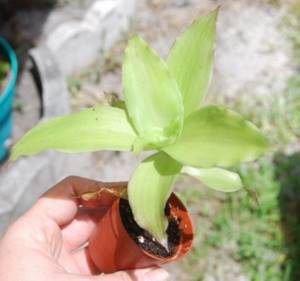
The most suitable is humus soil. It may contain turf or deciduous soil. Requires the addition of humus, peat and sand. A mixture of turf, humus and sand also works well. Be sure to place drainage at the bottom of the pot or vase.

Fragrant callisia is not only an ornamental houseplant, but its medicinal properties are also known.
Sources:
https://floristics.info/ru/stati/5322-kalliziya-v-domashnikh-usloviyakh-ukhod-i-foto.html https://rastenievod.com/kalliziya.html https://zelenyjmir.ru/kalliziya- dushistaya/
Reproduction
If fragrant callisia is chosen for cultivation, it can be planted in a flowerpot or wooden box. Reproduction occurs through layering, pieces of antennae, and cuttings.
It is best to carry out these procedures in early spring. To propagate by layering or tendrils, you need to cut off a shoot or tendril and place it in a container with water. Add a root growth stimulator. When the roots appear, plant the sprout in a flowerpot.
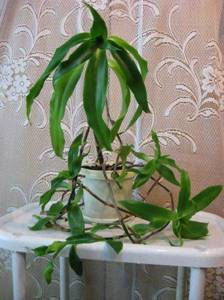
To carry out cuttings, you need to cut off the apical shoot with two nodes. The lower leaves are cut off, the upper ones are shortened by a third.
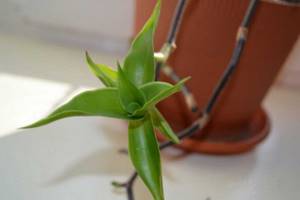
The sections should dry out, after which the fragrant callisia is planted in a pot, first you need to moisten the soil substrate abundantly.
